Pambamarca 2009, Galapagos Islands
[ Vacation Diaries ] [ Pambamarca 2009 ] [ Previous Page ] [ Next
Page ]
Thursday, July 30, 2009, Puerto Ayora, Santa Cruz Galapagos,
Ecuador, about 2000 ECT (GMT -7
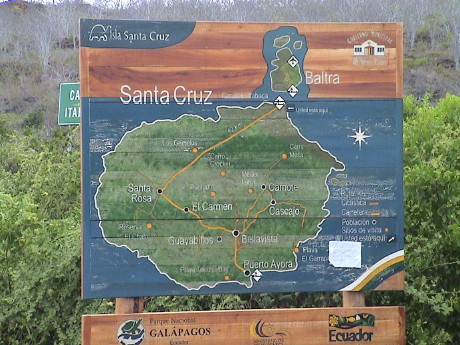 There are not many pictures today because we were traveling and I
didn't have the camera out most of the time. This is a map of the
island of Santa Cruz in the Galapagos group. This island group is
Ecuadorian and is located 600 miles west of the Ecuadorian coast right
on the equator. The airport is on a little volcanic rock named Baltra
just off the north coast of Santa Cruz. We took a bus from the airport
(a really small affair) to the channel between Baltra and Santa Cruz,
then a water taxi across the channel then another bus from the north
end of the island to the south end at Puerto Ayora.
There are not many pictures today because we were traveling and I
didn't have the camera out most of the time. This is a map of the
island of Santa Cruz in the Galapagos group. This island group is
Ecuadorian and is located 600 miles west of the Ecuadorian coast right
on the equator. The airport is on a little volcanic rock named Baltra
just off the north coast of Santa Cruz. We took a bus from the airport
(a really small affair) to the channel between Baltra and Santa Cruz,
then a water taxi across the channel then another bus from the north
end of the island to the south end at Puerto Ayora.
When we got to the airport, our checked bags weren't there. However,
when we asked the attendant at the exit, he asked if we were George and
Sandy. I knew something was up. We had checked in so early that our
bags got there on an earlier flight and they were locked up in an
office.
We didn't have any hotel reservations but we were assured when we
booked the flight that there would be plenty. We wandered through the
small town and found the hotel district, there were at least half a
dozen hotels. We booked a nice room for $30 a night at the Hotel
Espania. Our room is on the 4th floor (stairs only) but it has a TV
that gets CNN in english. There is WiFi in at the reception desk which
is an open air lobby.
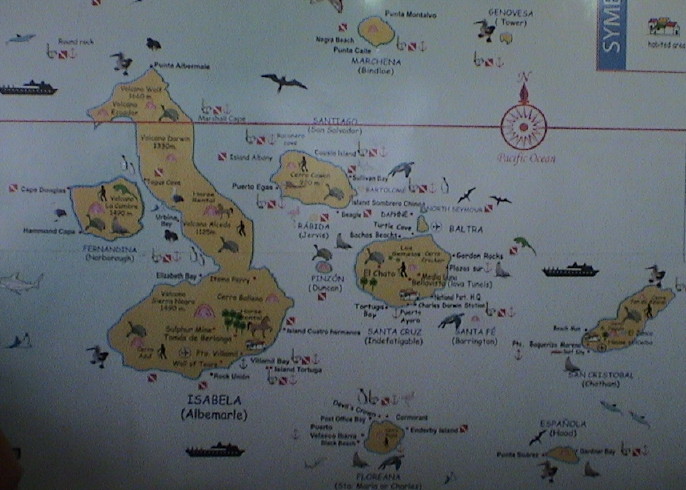 This map is painted on the wall of
the hotel reception desk. Santa Cruz island is the roundish one in the
middle. We're at the very southern tip of the island.
This map is painted on the wall of
the hotel reception desk. Santa Cruz island is the roundish one in the
middle. We're at the very southern tip of the island.
Each island has it's own ecosystem, many with species that don't
exist on the other islands. The Ecuadorian government is very
protective of the ecology here, the whole place is a national park.
Just to come here, they charge you $10 at the airport for a card, I'm
not sure what it does but collect $10 per person. Once you get here,
they collect another $100 park entrance fee, in cash, at the airport.
There is no ATM there and if you don't have the cash, I'm not sure what
happens.
About every other storefront here is an agency for booking tours. It
should not be hard to find something to do. We found a market and
bought some fruit, water, bread and a bottle of Fanta and then returned
to the room to rest before we went out in search of dinner.
It was starting to get darker by the time we wandered out for food.
There aren't a lot of restaurants here, but we found a good one right
downtown, as it were. I had an excellent piece of grilled fish, fries
and salad ($7) and Sandy had a "small" Hawaiian pizza (also about $7).
The pizza could have fed two. With a strawberry juice and a bottle of
Inca Cola (tastes like cream soda), tax and tip, the meal was $20.
By the time that we got our of the restaurant, it was getting dark
fast. This happens near the equator, the sun dives almost directly for
the horizon and doesn't waste any time getting there. In higher
latitudes, it slips below the horizon as it slides sideways and dusk
can extend for quite a while. Here, dusk lasts about 10 min.
We stopped by one tour shop to inquire about a snorkeling tour, An
all day snorkel and swimming trip was $85/head from the one shop.
Tomorrow, we'll shop around to see what the dozens of other tour shops
want for a similar tour.
The year around weather must be pretty mild here because many shops
are open to the air, maybe through bars, but nothing keeps the weather
out. Unlike the Andean highlands, it apparently doesn't get cold here
either. The hotel didn't even bother to put blankets on the beds.
Friday, July 31, 2009, Puerto Ayora, Santa Cruz Galapagos, Ecuador,
about 1600 CST (GMT -7)
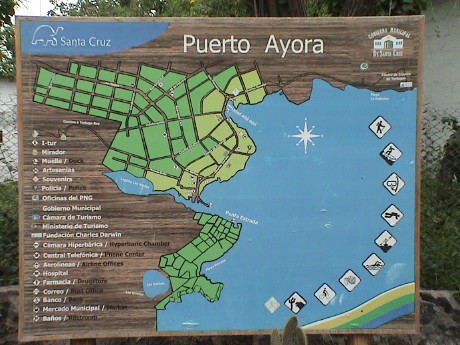 I went
out this morning to look around and scope out the town. The main harbor
is where the channel inland is, the fishing harbor is the little inlet
to the north.
I went
out this morning to look around and scope out the town. The main harbor
is where the channel inland is, the fishing harbor is the little inlet
to the north.
Sandy stayed behind with a case of Atawahlpa's revenge. Atawahlpa
was the last Inca king. We woke up last night at the same time with
"problems." Mine cleared immediately, Sandy was having difficulties all
night. It might have been the Inca Cola, I had a sip, she had the rest
of the bottle.
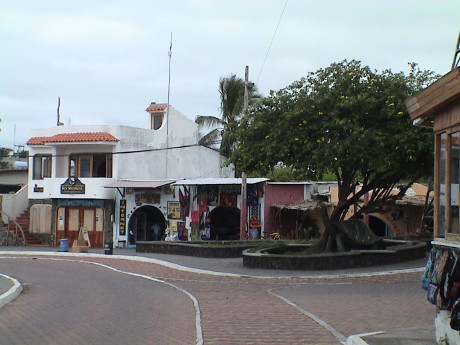 This is a
typical view from the street in the northern part of town which appears
to be the higher rent district. This area has the expensive hotels, the
most art galleries and nicer sidewalks.
This is a
typical view from the street in the northern part of town which appears
to be the higher rent district. This area has the expensive hotels, the
most art galleries and nicer sidewalks.
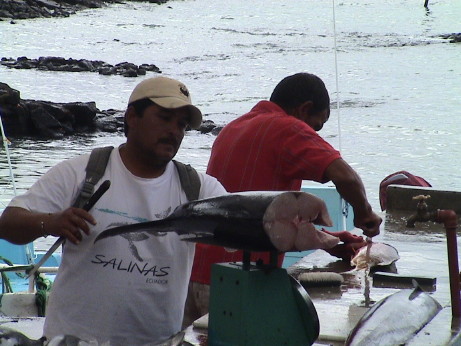 The fish
market was going strong early in the morning. There were many pelicans
hanging around looking for handouts.
The fish
market was going strong early in the morning. There were many pelicans
hanging around looking for handouts.
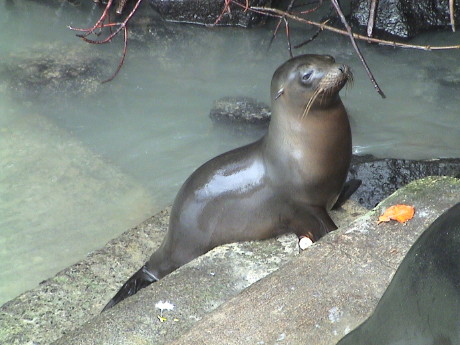 A couple
of sea lions came up the steps from the harbor also looking for
handouts and got some. Somebody was feeding them fish scraps.
A couple
of sea lions came up the steps from the harbor also looking for
handouts and got some. Somebody was feeding them fish scraps.
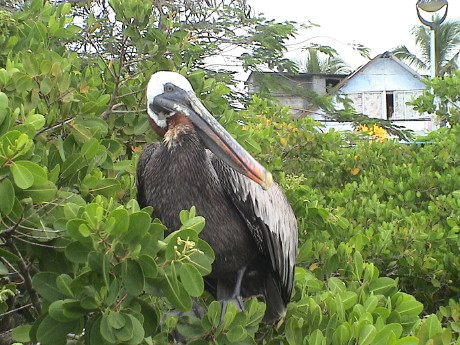 This pelican was
perched in a bush next to the fish market. These birds seem to show no
fear of humans. I sort of had to nudge them out of the way to walk
around. The sea lions didn't seem to care about people either. They've
probably been fed here every morning for years.
This pelican was
perched in a bush next to the fish market. These birds seem to show no
fear of humans. I sort of had to nudge them out of the way to walk
around. The sea lions didn't seem to care about people either. They've
probably been fed here every morning for years.
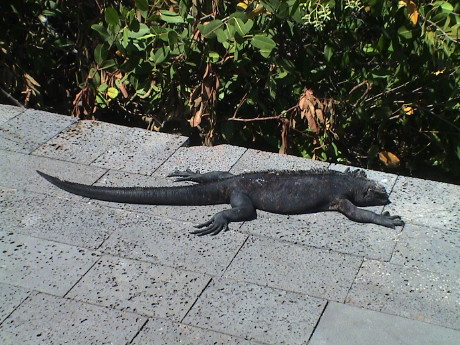 After
Atawahlpa gave Sandy the afternoon off we got some lunch then wandered
out for a walk to the Charles Darwin Center for a look around. The
center is located about 1 km north of the edge of town. On the way, we
saw this marine iguana sunning himself on the sidewalk near the fish
market, totally oblivious to the pedestrian traffic going right by.
After
Atawahlpa gave Sandy the afternoon off we got some lunch then wandered
out for a walk to the Charles Darwin Center for a look around. The
center is located about 1 km north of the edge of town. On the way, we
saw this marine iguana sunning himself on the sidewalk near the fish
market, totally oblivious to the pedestrian traffic going right by.
 We found the trail to the Charles Darwin Center's displays and
wandered in. They breed tortoises there, these are less than 5 years
old. If the adult tortoises lay their eggs in the center, feral pigs,
dogs and cats will finds the nests and dig them up. The center staff
scouts the adult pens every day looking for fresh nests and then takes
the eggs to incubate in safety. Nests and baby tortoises from other
islands are also collected and kept separate sorted by the island that
they came from. Once the tortoises are hatched, the hatchlings are
cared for in safety. As they get larger, they are moved to pens that
more and more are like their wild environment. When they are large
enough to survive in the wild, they are returned to their native
islands after being tagged with an RFID tag.
We found the trail to the Charles Darwin Center's displays and
wandered in. They breed tortoises there, these are less than 5 years
old. If the adult tortoises lay their eggs in the center, feral pigs,
dogs and cats will finds the nests and dig them up. The center staff
scouts the adult pens every day looking for fresh nests and then takes
the eggs to incubate in safety. Nests and baby tortoises from other
islands are also collected and kept separate sorted by the island that
they came from. Once the tortoises are hatched, the hatchlings are
cared for in safety. As they get larger, they are moved to pens that
more and more are like their wild environment. When they are large
enough to survive in the wild, they are returned to their native
islands after being tagged with an RFID tag.
 There is a large "cactus tree" that grows here. It is kind of a
prickly pear, which tortoises in the California desert love, but it
grows tall like a tree to protect itself from tortoises and iguanas. It
grows only 1 to 2 cm a year so the sample behind Sandy is 300 to 500
years old.
There is a large "cactus tree" that grows here. It is kind of a
prickly pear, which tortoises in the California desert love, but it
grows tall like a tree to protect itself from tortoises and iguanas. It
grows only 1 to 2 cm a year so the sample behind Sandy is 300 to 500
years old.
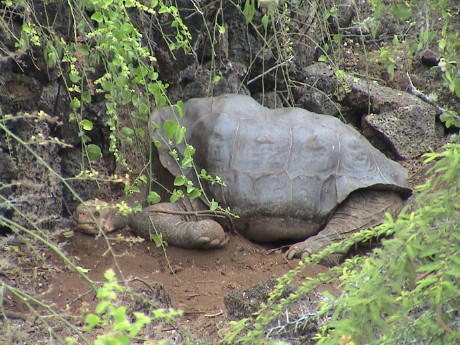 This large male is called "Lonesome George." He was the last living
tortoise collected from Pinta Island in 1972. He is called a saddleback
tortoise for the shape of his shell. He has been placed in an enclosure
with two female saddleback tortoises from nearby Wolf Island but he has
never mated in captivity. 37+ years is a long time to go without
getting any.
This large male is called "Lonesome George." He was the last living
tortoise collected from Pinta Island in 1972. He is called a saddleback
tortoise for the shape of his shell. He has been placed in an enclosure
with two female saddleback tortoises from nearby Wolf Island but he has
never mated in captivity. 37+ years is a long time to go without
getting any.
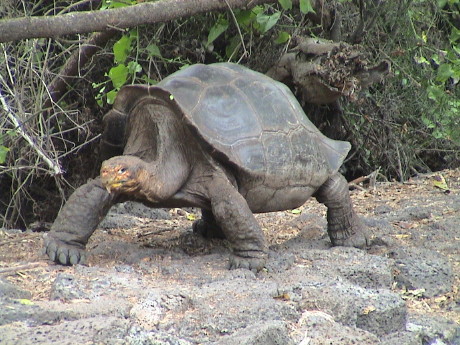 Many tortoises had been previously captured and kept by private
owners. The government rounded them up and placed them at the center.
This is one of them. It was just wandering down the trail we were
taking and walked on by, not paying us any attention at all.
Many tortoises had been previously captured and kept by private
owners. The government rounded them up and placed them at the center.
This is one of them. It was just wandering down the trail we were
taking and walked on by, not paying us any attention at all.
 This is a large male land iguana. These are different from the black
marine iguanas which swim in the ocean to feed. This large one is
sunning himself to try to raise his body temperature to the level where
he can become active.
This is a large male land iguana. These are different from the black
marine iguanas which swim in the ocean to feed. This large one is
sunning himself to try to raise his body temperature to the level where
he can become active.
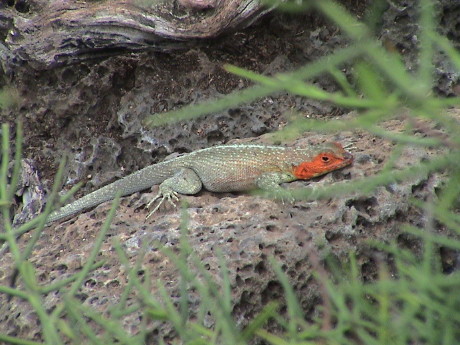 These little green and red lizards were all over the place. This one
was in a pen of large male tortoises, posing for a picture.
These little green and red lizards were all over the place. This one
was in a pen of large male tortoises, posing for a picture.
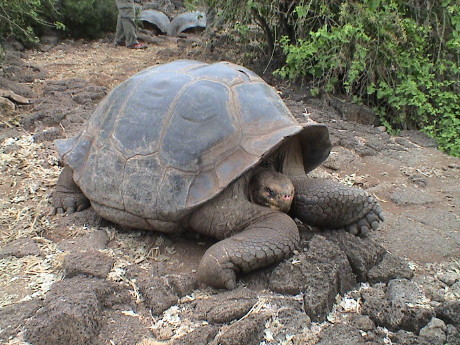 The large male tortoises that had been collected by the government
from private owners are kept in a separate pen. These guys can grow to
600 lbs.
The large male tortoises that had been collected by the government
from private owners are kept in a separate pen. These guys can grow to
600 lbs.
There is one large male, collected in the wild, who is used for
breeding because they know where he came from. His name is Diego and
the breeders figure that he is the father to about 2000 baby tortoises
that have been hatched at the center. These hatchlings represent about
8% of the tortoises now living in the Galapagos.
Saturday, August 1, 2009, Puerto Ayora, Santa Cruz Galapagos,
Ecuador, about 2000 CST (GMT -7)
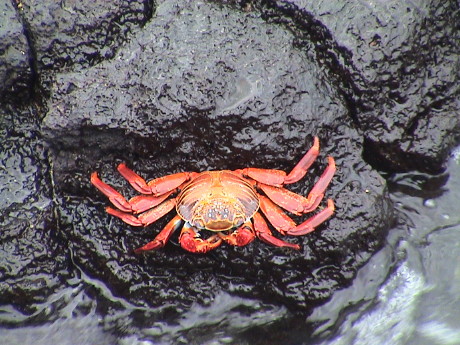 We didn't do much of
anything today. Sandy was feeling better, but I wasn't feeling so well.
Hopefully, we'll be able to get out more tomorrow.
We didn't do much of
anything today. Sandy was feeling better, but I wasn't feeling so well.
Hopefully, we'll be able to get out more tomorrow.
We did go out walking by the harbor late in the day and I caught a
picture of this red crab on the rocks next to a pier. These things are
all over the place.
Sunday, August 2, 2009, Puerto Ayora, Santa Cruz Galapagos,
Ecuador, about 1500 CST (GMT -7)
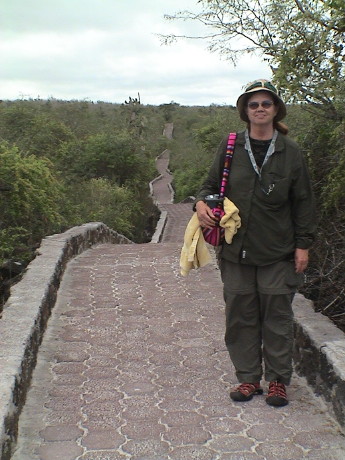 Today,
we elected to got to Tortuga Bay which is just west of Puerto Ayora. It
was recommended that we take a taxi to get to the entrance station, the
ride was $1. Had we known exactly where it was, we could have walked it
easily. The trail is about 2.5 km long and goes mostly straight to the
beach. It is paved with concrete paving stones the whole way, 7 wide by
about 4 to the meter, or about 70,000 stones.
Today,
we elected to got to Tortuga Bay which is just west of Puerto Ayora. It
was recommended that we take a taxi to get to the entrance station, the
ride was $1. Had we known exactly where it was, we could have walked it
easily. The trail is about 2.5 km long and goes mostly straight to the
beach. It is paved with concrete paving stones the whole way, 7 wide by
about 4 to the meter, or about 70,000 stones.
 The edge is lined
in a low volcanic stone and concrete wall. Lizards like these liked to
sun themselves on the edge and tended to vanish against the concrete.
These guys were all over the place, we tended to startle one every few
meters or so.
The edge is lined
in a low volcanic stone and concrete wall. Lizards like these liked to
sun themselves on the edge and tended to vanish against the concrete.
These guys were all over the place, we tended to startle one every few
meters or so.
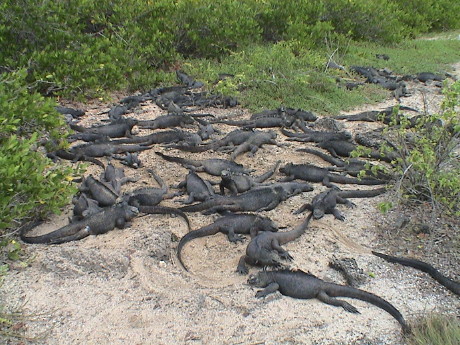 After the
2.5 km walk to the beach, we walked another km or so up the beach to
the other end. There was a loop trail through a peninsula that forms
the north end of the beach. Along this trail we found just a few marine
iguanas. This was the largest single group, but there were hundreds of
them in total.
After the
2.5 km walk to the beach, we walked another km or so up the beach to
the other end. There was a loop trail through a peninsula that forms
the north end of the beach. Along this trail we found just a few marine
iguanas. This was the largest single group, but there were hundreds of
them in total.
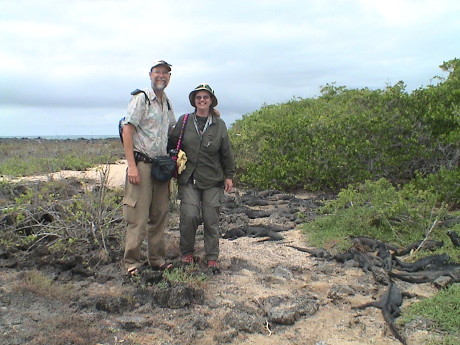 This group was sleeping on the trail itself, we had to walk off the
trail to get around them. They didn't care a whit about us.
This group was sleeping on the trail itself, we had to walk off the
trail to get around them. They didn't care a whit about us.
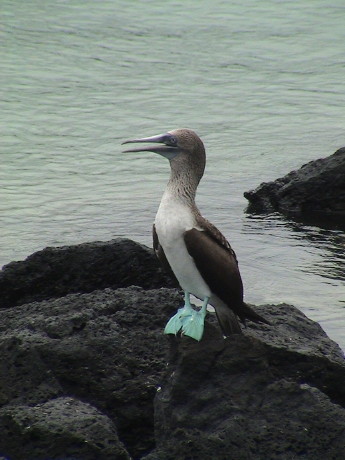 On
the protected side of the peninsula, we found three blue footed boobies
like this one. There is also a red footed boobie that has a blue beak,
but we didn't see any of those.
On
the protected side of the peninsula, we found three blue footed boobies
like this one. There is also a red footed boobie that has a blue beak,
but we didn't see any of those.
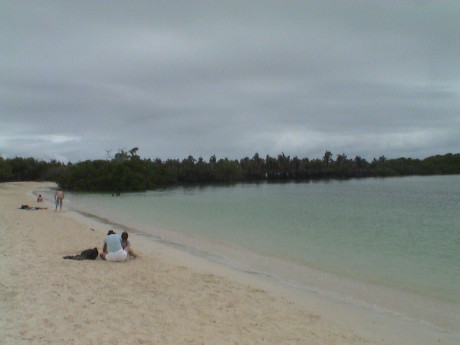 Protected
by the peninsula is another smaller beach that has virtually no surf, a
fine white sand beach and very clear water. This is where most of the
people were. The main beach is marked as dangerous with strong rip
currents.
Protected
by the peninsula is another smaller beach that has virtually no surf, a
fine white sand beach and very clear water. This is where most of the
people were. The main beach is marked as dangerous with strong rip
currents.
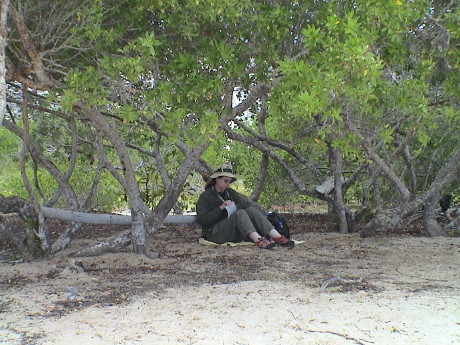 We picked a spot
under some trees to eat lunch. A bunch of finches came by to help us.
They had absolutely no fear of humans and would literally try to grab
food right from my hand, either on the fly or by landing right on my
wrist.
We picked a spot
under some trees to eat lunch. A bunch of finches came by to help us.
They had absolutely no fear of humans and would literally try to grab
food right from my hand, either on the fly or by landing right on my
wrist.
After a little while on the beach, we walked back to our hotel. My
pedometer indicated 7200 net steps on the way back, or about 3.5
miles.
At 1300, almost this whole place closes up tight for siesta until
about 1500. Some of the travel agencies stay open, but if you want
food, you're out of luck. On a Sunday, the restaurants that will open
at all will not open again until 1900. We did manage to book a
"highland" tour for tomorrow afternoon. We'll see some lava tubes and
perhaps some giant tortoises in the wild along with other flora and
fauna. That will take up up until about dinner time. The day after
that, Tuesday we get up early to catch the bus to Baltra to fly back to
Quito. On Wednesday afternoon, it's back to the Quito airport to fly
home.
Monday, August 3, 2009, Puerto Ayora, Santa Cruz Galapagos,
Ecuador, about 1700 CST (GMT -7)
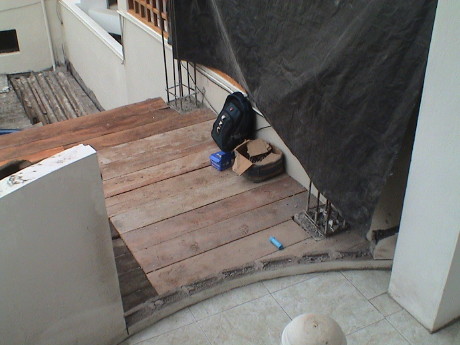 The whole time we've been here, there has been construction going on.
After watching them for a few days, it appears that they are adding an
extension to the this hotel. The technique appears to be common in
latin america, poured pillars and floors make the building frame and
the gaps between the pillars are filled with concrete blocks to provide
shear strength.
The whole time we've been here, there has been construction going on.
After watching them for a few days, it appears that they are adding an
extension to the this hotel. The technique appears to be common in
latin america, poured pillars and floors make the building frame and
the gaps between the pillars are filled with concrete blocks to provide
shear strength.
In this picture, the wall at the landing of the stairwell has been
cut away to eventually allow access to the new addition. The tops of a
couple of pillars that were poured last week can be seen against the
wall.
It is clear that they are going up at least one floor higher than
this one as the next landing up has been cut away too.
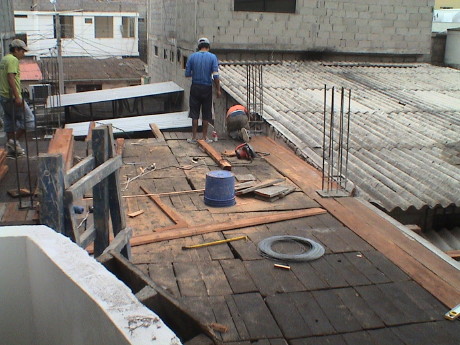 Each pillar has six pieces of vertical rebar with a wire cage wrapped
around the rebar several times a meter. The cage helps prevent the
pillar from exploding when it fractures in an earthquake. The pillar
may be destroyed, but at least it will not collapse completely as
crushed concrete will still be trapped in the rebar cage.
Each pillar has six pieces of vertical rebar with a wire cage wrapped
around the rebar several times a meter. The cage helps prevent the
pillar from exploding when it fractures in an earthquake. The pillar
may be destroyed, but at least it will not collapse completely as
crushed concrete will still be trapped in the rebar cage.
The wooden platform is a form for the next floor. A pattern of rebar
will be formed horizontally in the floor overlapping the pillars. The
rebar sticking out of the existing pillars forms a connection for the
pillar that will support the next floor. It is very common to see rebar
stick out out of the roofs of buildings here to provide support for new
construction that is not yet built.
 The wooden floor forms are supported underneath with temporary
scaffolding. These are resting on a floor that was poured before we got
here.
The wooden floor forms are supported underneath with temporary
scaffolding. These are resting on a floor that was poured before we got
here.
The concrete block walls and poured pillars of the adjacent building
can be seen here. The mortar joints in the concrete blocks are usually
not finished cleanly on walls that don't face the street. The new
construction for this hotel will clearly block some windows for rooms
on the adjacent hotel.
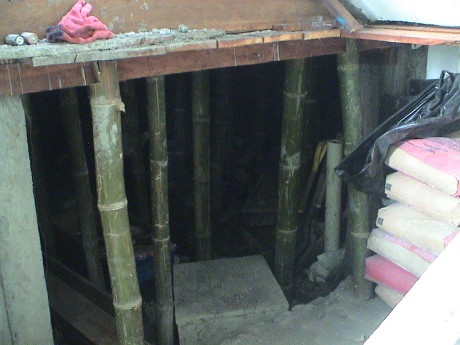 That floor is supported on bamboo scaffolding as there isn't enough
room for the metal supports used on the next floor.
That floor is supported on bamboo scaffolding as there isn't enough
room for the metal supports used on the next floor.
These guys don't appear to be working to any specific plan. It
appears that they just stake out the area to be built and dive in using
standard construction techniques. I doubt that there is a formal
permitting process either.
Utilities are not provided for in exterior walls. The building
structure is built and then utilities are added later, mostly in
interior walls. Bathroom floors are often raised about a room's floor
level to allow utilities to be run under the bathroom floor.
If poorly done, this kind of construction is prone to "pancake" in
an earthquake. If the pillars don't have enough of the right rebar in
them, the shaking will crush the concrete and the dust will simply blow
out of the pillar. The remaining rebar is insufficient to hold much of
anything and the column collapses. The flat floors then smash down
against each other crushing everything and everybody in the building.
The basic pillar and floor construction doesn't have much shear
strength. Without sufficient filling between the pillars, the whole
thing can also topple like a house of cards, with similar results.
However, with proper construction, the building my be functionally
destroyed in an earthquake, but the occupants can still escape as the
structure will not collapse completely.
Buildings are built right up next to each other as well so that
adjacent structures can help hold each other up.
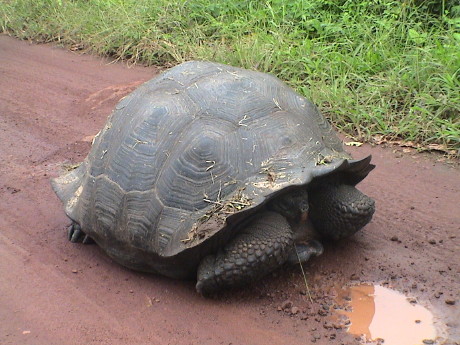 In the afternoon, we took a "highland" tour of the interior of Santa
Cruz island. One of the objectives was to find some giant tortoises. It
didn't take us long to find one, he was sitting in the road.
In the afternoon, we took a "highland" tour of the interior of Santa
Cruz island. One of the objectives was to find some giant tortoises. It
didn't take us long to find one, he was sitting in the road.
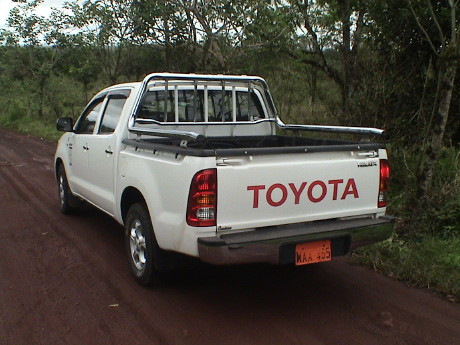 Since the
agency that we booked the tour with didn't have anybody but us today,
they booked a taxi so we had a private car and driver instead of a
small tour bus. The driver didn't speak english, but Sandy's spanish is
good enough that we got by just fine.
Since the
agency that we booked the tour with didn't have anybody but us today,
they booked a taxi so we had a private car and driver instead of a
small tour bus. The driver didn't speak english, but Sandy's spanish is
good enough that we got by just fine.
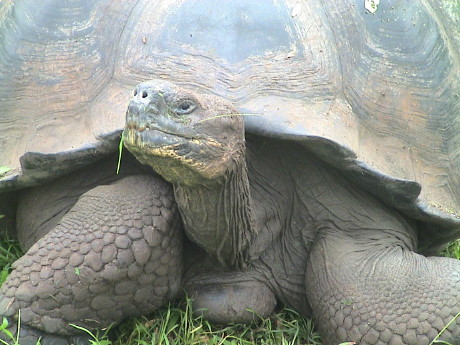 He took us to a private farm that happens to typically have lots of
tortoises on it. They had a large dining room set up but when we got
there, we were the only ones there.
He took us to a private farm that happens to typically have lots of
tortoises on it. They had a large dining room set up but when we got
there, we were the only ones there.
The taxi driver escorted us through some muddy fields and we ran
across 18 tortoises, all of them noshing on the thick grasses and
plants on the "farm." These are not captive to the farm, tortoises have
first rights to any land on the island. They roam freely but typically
over a limited range where their favorite plants can be found. The
tortoises spend much of the day grazing. They eat so much fiber rich
plants that they also leave very large droppings behind. The fields
were covered with them.
Then the driver took us to a nearby lava tube. This was a large tube
with an improved (dirt) floor and electric lighting. The tube went for
a considerably further distance than we went, maybe 200 meters. After
that the floor gets much rougher and wetter. It was too dark inside for
my camera to take any good pictures as my video camera doesn't have a
flash. Sandy may have some that I can add later.
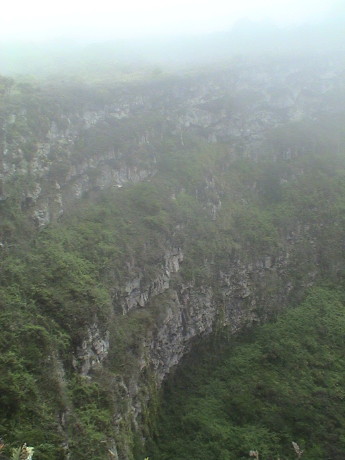 Up
the road a little further into the cloud forest were three sinkholes.
This was the medium sized one, it was probably 100 to 150 meters wide
and more than 50 meters deep. The smallest one was only 10 or 15 meters
wide but I could not see the bottom. The largest one was maybe 200
meters wide and also about 50 meters deep.
Up
the road a little further into the cloud forest were three sinkholes.
This was the medium sized one, it was probably 100 to 150 meters wide
and more than 50 meters deep. The smallest one was only 10 or 15 meters
wide but I could not see the bottom. The largest one was maybe 200
meters wide and also about 50 meters deep.
In the five days that we've been on this island, we've seen samples
of pretty much everything that is here. The rest of the scenery is on
other islands. The diving here is supposed to be excellent, but I
elected not to do any snorkel or dive trips time.
By tomorrow afternoon, we should be back in Quito for the night. We'll fly out 24 hours later barring some unforseen problem.
[ Vacation Diaries ] [ Pambamarca 2009 ] [ Previous Page ] [ Next
Page ]
© 2009 George Schreyer
Created 30 Jul 09
Last Updated August 4, 2009
 There are not many pictures today because we were traveling and I
didn't have the camera out most of the time. This is a map of the
island of Santa Cruz in the Galapagos group. This island group is
Ecuadorian and is located 600 miles west of the Ecuadorian coast right
on the equator. The airport is on a little volcanic rock named Baltra
just off the north coast of Santa Cruz. We took a bus from the airport
(a really small affair) to the channel between Baltra and Santa Cruz,
then a water taxi across the channel then another bus from the north
end of the island to the south end at Puerto Ayora.
There are not many pictures today because we were traveling and I
didn't have the camera out most of the time. This is a map of the
island of Santa Cruz in the Galapagos group. This island group is
Ecuadorian and is located 600 miles west of the Ecuadorian coast right
on the equator. The airport is on a little volcanic rock named Baltra
just off the north coast of Santa Cruz. We took a bus from the airport
(a really small affair) to the channel between Baltra and Santa Cruz,
then a water taxi across the channel then another bus from the north
end of the island to the south end at Puerto Ayora. This map is painted on the wall of
the hotel reception desk. Santa Cruz island is the roundish one in the
middle. We're at the very southern tip of the island.
This map is painted on the wall of
the hotel reception desk. Santa Cruz island is the roundish one in the
middle. We're at the very southern tip of the island. I went
out this morning to look around and scope out the town. The main harbor
is where the channel inland is, the fishing harbor is the little inlet
to the north.
I went
out this morning to look around and scope out the town. The main harbor
is where the channel inland is, the fishing harbor is the little inlet
to the north. This is a
typical view from the street in the northern part of town which appears
to be the higher rent district. This area has the expensive hotels, the
most art galleries and nicer sidewalks.
This is a
typical view from the street in the northern part of town which appears
to be the higher rent district. This area has the expensive hotels, the
most art galleries and nicer sidewalks. The fish
market was going strong early in the morning. There were many pelicans
hanging around looking for handouts.
The fish
market was going strong early in the morning. There were many pelicans
hanging around looking for handouts. A couple
of sea lions came up the steps from the harbor also looking for
handouts and got some. Somebody was feeding them fish scraps.
A couple
of sea lions came up the steps from the harbor also looking for
handouts and got some. Somebody was feeding them fish scraps. This pelican was
perched in a bush next to the fish market. These birds seem to show no
fear of humans. I sort of had to nudge them out of the way to walk
around. The sea lions didn't seem to care about people either. They've
probably been fed here every morning for years.
This pelican was
perched in a bush next to the fish market. These birds seem to show no
fear of humans. I sort of had to nudge them out of the way to walk
around. The sea lions didn't seem to care about people either. They've
probably been fed here every morning for years. After
Atawahlpa gave Sandy the afternoon off we got some lunch then wandered
out for a walk to the Charles Darwin Center for a look around. The
center is located about 1 km north of the edge of town. On the way, we
saw this marine iguana sunning himself on the sidewalk near the fish
market, totally oblivious to the pedestrian traffic going right by.
After
Atawahlpa gave Sandy the afternoon off we got some lunch then wandered
out for a walk to the Charles Darwin Center for a look around. The
center is located about 1 km north of the edge of town. On the way, we
saw this marine iguana sunning himself on the sidewalk near the fish
market, totally oblivious to the pedestrian traffic going right by. We found the trail to the Charles Darwin Center's displays and
wandered in. They breed tortoises there, these are less than 5 years
old. If the adult tortoises lay their eggs in the center, feral pigs,
dogs and cats will finds the nests and dig them up. The center staff
scouts the adult pens every day looking for fresh nests and then takes
the eggs to incubate in safety. Nests and baby tortoises from other
islands are also collected and kept separate sorted by the island that
they came from. Once the tortoises are hatched, the hatchlings are
cared for in safety. As they get larger, they are moved to pens that
more and more are like their wild environment. When they are large
enough to survive in the wild, they are returned to their native
islands after being tagged with an RFID tag.
We found the trail to the Charles Darwin Center's displays and
wandered in. They breed tortoises there, these are less than 5 years
old. If the adult tortoises lay their eggs in the center, feral pigs,
dogs and cats will finds the nests and dig them up. The center staff
scouts the adult pens every day looking for fresh nests and then takes
the eggs to incubate in safety. Nests and baby tortoises from other
islands are also collected and kept separate sorted by the island that
they came from. Once the tortoises are hatched, the hatchlings are
cared for in safety. As they get larger, they are moved to pens that
more and more are like their wild environment. When they are large
enough to survive in the wild, they are returned to their native
islands after being tagged with an RFID tag. There is a large "cactus tree" that grows here. It is kind of a
prickly pear, which tortoises in the California desert love, but it
grows tall like a tree to protect itself from tortoises and iguanas. It
grows only 1 to 2 cm a year so the sample behind Sandy is 300 to 500
years old.
There is a large "cactus tree" that grows here. It is kind of a
prickly pear, which tortoises in the California desert love, but it
grows tall like a tree to protect itself from tortoises and iguanas. It
grows only 1 to 2 cm a year so the sample behind Sandy is 300 to 500
years old. This large male is called "Lonesome George." He was the last living
tortoise collected from Pinta Island in 1972. He is called a saddleback
tortoise for the shape of his shell. He has been placed in an enclosure
with two female saddleback tortoises from nearby Wolf Island but he has
never mated in captivity. 37+ years is a long time to go without
getting any.
This large male is called "Lonesome George." He was the last living
tortoise collected from Pinta Island in 1972. He is called a saddleback
tortoise for the shape of his shell. He has been placed in an enclosure
with two female saddleback tortoises from nearby Wolf Island but he has
never mated in captivity. 37+ years is a long time to go without
getting any. Many tortoises had been previously captured and kept by private
owners. The government rounded them up and placed them at the center.
This is one of them. It was just wandering down the trail we were
taking and walked on by, not paying us any attention at all.
Many tortoises had been previously captured and kept by private
owners. The government rounded them up and placed them at the center.
This is one of them. It was just wandering down the trail we were
taking and walked on by, not paying us any attention at all. This is a large male land iguana. These are different from the black
marine iguanas which swim in the ocean to feed. This large one is
sunning himself to try to raise his body temperature to the level where
he can become active.
This is a large male land iguana. These are different from the black
marine iguanas which swim in the ocean to feed. This large one is
sunning himself to try to raise his body temperature to the level where
he can become active. These little green and red lizards were all over the place. This one
was in a pen of large male tortoises, posing for a picture.
These little green and red lizards were all over the place. This one
was in a pen of large male tortoises, posing for a picture. The large male tortoises that had been collected by the government
from private owners are kept in a separate pen. These guys can grow to
600 lbs.
The large male tortoises that had been collected by the government
from private owners are kept in a separate pen. These guys can grow to
600 lbs. We didn't do much of
anything today. Sandy was feeling better, but I wasn't feeling so well.
Hopefully, we'll be able to get out more tomorrow.
We didn't do much of
anything today. Sandy was feeling better, but I wasn't feeling so well.
Hopefully, we'll be able to get out more tomorrow. Today,
we elected to got to Tortuga Bay which is just west of Puerto Ayora. It
was recommended that we take a taxi to get to the entrance station, the
ride was $1. Had we known exactly where it was, we could have walked it
easily. The trail is about 2.5 km long and goes mostly straight to the
beach. It is paved with concrete paving stones the whole way, 7 wide by
about 4 to the meter, or about 70,000 stones.
Today,
we elected to got to Tortuga Bay which is just west of Puerto Ayora. It
was recommended that we take a taxi to get to the entrance station, the
ride was $1. Had we known exactly where it was, we could have walked it
easily. The trail is about 2.5 km long and goes mostly straight to the
beach. It is paved with concrete paving stones the whole way, 7 wide by
about 4 to the meter, or about 70,000 stones. The edge is lined
in a low volcanic stone and concrete wall. Lizards like these liked to
sun themselves on the edge and tended to vanish against the concrete.
These guys were all over the place, we tended to startle one every few
meters or so.
The edge is lined
in a low volcanic stone and concrete wall. Lizards like these liked to
sun themselves on the edge and tended to vanish against the concrete.
These guys were all over the place, we tended to startle one every few
meters or so. After the
2.5 km walk to the beach, we walked another km or so up the beach to
the other end. There was a loop trail through a peninsula that forms
the north end of the beach. Along this trail we found just a few marine
iguanas. This was the largest single group, but there were hundreds of
them in total.
After the
2.5 km walk to the beach, we walked another km or so up the beach to
the other end. There was a loop trail through a peninsula that forms
the north end of the beach. Along this trail we found just a few marine
iguanas. This was the largest single group, but there were hundreds of
them in total. This group was sleeping on the trail itself, we had to walk off the
trail to get around them. They didn't care a whit about us.
This group was sleeping on the trail itself, we had to walk off the
trail to get around them. They didn't care a whit about us. On
the protected side of the peninsula, we found three blue footed boobies
like this one. There is also a red footed boobie that has a blue beak,
but we didn't see any of those.
On
the protected side of the peninsula, we found three blue footed boobies
like this one. There is also a red footed boobie that has a blue beak,
but we didn't see any of those. Protected
by the peninsula is another smaller beach that has virtually no surf, a
fine white sand beach and very clear water. This is where most of the
people were. The main beach is marked as dangerous with strong rip
currents.
Protected
by the peninsula is another smaller beach that has virtually no surf, a
fine white sand beach and very clear water. This is where most of the
people were. The main beach is marked as dangerous with strong rip
currents. We picked a spot
under some trees to eat lunch. A bunch of finches came by to help us.
They had absolutely no fear of humans and would literally try to grab
food right from my hand, either on the fly or by landing right on my
wrist.
We picked a spot
under some trees to eat lunch. A bunch of finches came by to help us.
They had absolutely no fear of humans and would literally try to grab
food right from my hand, either on the fly or by landing right on my
wrist. The whole time we've been here, there has been construction going on.
After watching them for a few days, it appears that they are adding an
extension to the this hotel. The technique appears to be common in
latin america, poured pillars and floors make the building frame and
the gaps between the pillars are filled with concrete blocks to provide
shear strength.
The whole time we've been here, there has been construction going on.
After watching them for a few days, it appears that they are adding an
extension to the this hotel. The technique appears to be common in
latin america, poured pillars and floors make the building frame and
the gaps between the pillars are filled with concrete blocks to provide
shear strength. Each pillar has six pieces of vertical rebar with a wire cage wrapped
around the rebar several times a meter. The cage helps prevent the
pillar from exploding when it fractures in an earthquake. The pillar
may be destroyed, but at least it will not collapse completely as
crushed concrete will still be trapped in the rebar cage.
Each pillar has six pieces of vertical rebar with a wire cage wrapped
around the rebar several times a meter. The cage helps prevent the
pillar from exploding when it fractures in an earthquake. The pillar
may be destroyed, but at least it will not collapse completely as
crushed concrete will still be trapped in the rebar cage. The wooden floor forms are supported underneath with temporary
scaffolding. These are resting on a floor that was poured before we got
here.
The wooden floor forms are supported underneath with temporary
scaffolding. These are resting on a floor that was poured before we got
here. That floor is supported on bamboo scaffolding as there isn't enough
room for the metal supports used on the next floor.
That floor is supported on bamboo scaffolding as there isn't enough
room for the metal supports used on the next floor. In the afternoon, we took a "highland" tour of the interior of Santa
Cruz island. One of the objectives was to find some giant tortoises. It
didn't take us long to find one, he was sitting in the road.
In the afternoon, we took a "highland" tour of the interior of Santa
Cruz island. One of the objectives was to find some giant tortoises. It
didn't take us long to find one, he was sitting in the road. Since the
agency that we booked the tour with didn't have anybody but us today,
they booked a taxi so we had a private car and driver instead of a
small tour bus. The driver didn't speak english, but Sandy's spanish is
good enough that we got by just fine.
Since the
agency that we booked the tour with didn't have anybody but us today,
they booked a taxi so we had a private car and driver instead of a
small tour bus. The driver didn't speak english, but Sandy's spanish is
good enough that we got by just fine. He took us to a private farm that happens to typically have lots of
tortoises on it. They had a large dining room set up but when we got
there, we were the only ones there.
He took us to a private farm that happens to typically have lots of
tortoises on it. They had a large dining room set up but when we got
there, we were the only ones there. Up
the road a little further into the cloud forest were three sinkholes.
This was the medium sized one, it was probably 100 to 150 meters wide
and more than 50 meters deep. The smallest one was only 10 or 15 meters
wide but I could not see the bottom. The largest one was maybe 200
meters wide and also about 50 meters deep.
Up
the road a little further into the cloud forest were three sinkholes.
This was the medium sized one, it was probably 100 to 150 meters wide
and more than 50 meters deep. The smallest one was only 10 or 15 meters
wide but I could not see the bottom. The largest one was maybe 200
meters wide and also about 50 meters deep.